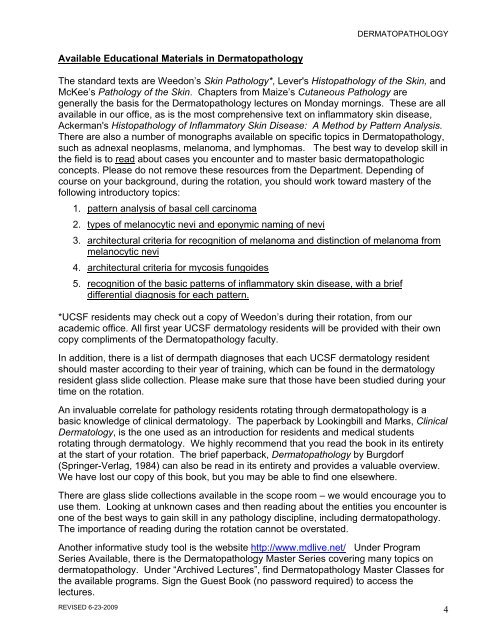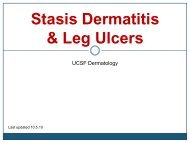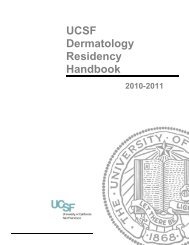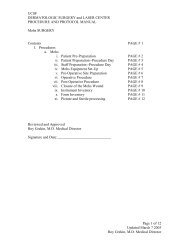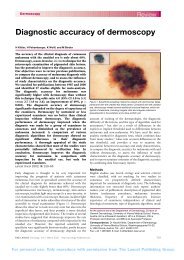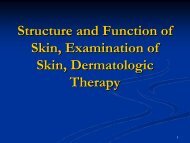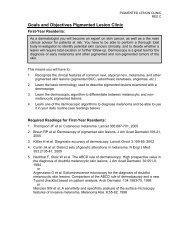Welcome to Dermatopathology - Dermatology
Welcome to Dermatopathology - Dermatology
Welcome to Dermatopathology - Dermatology
Create successful ePaper yourself
Turn your PDF publications into a flip-book with our unique Google optimized e-Paper software.
Available Educational Materials in Derma<strong>to</strong>pathology<br />
DERMATOPATHOLOGY<br />
The standard texts are Weedon’s Skin Pathology*, Lever's His<strong>to</strong>pathology of the Skin, and<br />
McKee’s Pathology of the Skin. Chapters from Maize’s Cutaneous Pathology are<br />
generally the basis for the Derma<strong>to</strong>pathology lectures on Monday mornings. These are all<br />
available in our office, as is the most comprehensive text on inflamma<strong>to</strong>ry skin disease,<br />
Ackerman's His<strong>to</strong>pathology of Inflamma<strong>to</strong>ry Skin Disease: A Method by Pattern Analysis.<br />
There are also a number of monographs available on specific <strong>to</strong>pics in Derma<strong>to</strong>pathology,<br />
such as adnexal neoplasms, melanoma, and lymphomas. The best way <strong>to</strong> develop skill in<br />
the field is <strong>to</strong> read about cases you encounter and <strong>to</strong> master basic derma<strong>to</strong>pathologic<br />
concepts. Please do not remove these resources from the Department. Depending of<br />
course on your background, during the rotation, you should work <strong>to</strong>ward mastery of the<br />
following introduc<strong>to</strong>ry <strong>to</strong>pics:<br />
1. pattern analysis of basal cell carcinoma<br />
2. types of melanocytic nevi and eponymic naming of nevi<br />
3. architectural criteria for recognition of melanoma and distinction of melanoma from<br />
melanocytic nevi<br />
4. architectural criteria for mycosis fungoides<br />
5. recognition of the basic patterns of inflamma<strong>to</strong>ry skin disease, with a brief<br />
differential diagnosis for each pattern.<br />
*UCSF residents may check out a copy of Weedon’s during their rotation, from our<br />
academic office. All first year UCSF derma<strong>to</strong>logy residents will be provided with their own<br />
copy compliments of the Derma<strong>to</strong>pathology faculty.<br />
In addition, there is a list of dermpath diagnoses that each UCSF derma<strong>to</strong>logy resident<br />
should master according <strong>to</strong> their year of training, which can be found in the derma<strong>to</strong>logy<br />
resident glass slide collection. Please make sure that those have been studied during your<br />
time on the rotation.<br />
An invaluable correlate for pathology residents rotating through derma<strong>to</strong>pathology is a<br />
basic knowledge of clinical derma<strong>to</strong>logy. The paperback by Lookingbill and Marks, Clinical<br />
Derma<strong>to</strong>logy, is the one used as an introduction for residents and medical students<br />
rotating through derma<strong>to</strong>logy. We highly recommend that you read the book in its entirety<br />
at the start of your rotation. The brief paperback, Derma<strong>to</strong>pathology by Burgdorf<br />
(Springer-Verlag, 1984) can also be read in its entirety and provides a valuable overview.<br />
We have lost our copy of this book, but you may be able <strong>to</strong> find one elsewhere.<br />
There are glass slide collections available in the scope room – we would encourage you <strong>to</strong><br />
use them. Looking at unknown cases and then reading about the entities you encounter is<br />
one of the best ways <strong>to</strong> gain skill in any pathology discipline, including derma<strong>to</strong>pathology.<br />
The importance of reading during the rotation cannot be overstated.<br />
Another informative study <strong>to</strong>ol is the website http://www.mdlive.net/ Under Program<br />
Series Available, there is the Derma<strong>to</strong>pathology Master Series covering many <strong>to</strong>pics on<br />
derma<strong>to</strong>pathology. Under “Archived Lectures”, find Derma<strong>to</strong>pathology Master Classes for<br />
the available programs. Sign the Guest Book (no password required) <strong>to</strong> access the<br />
lectures.<br />
REVISED 6-23-2009 4


